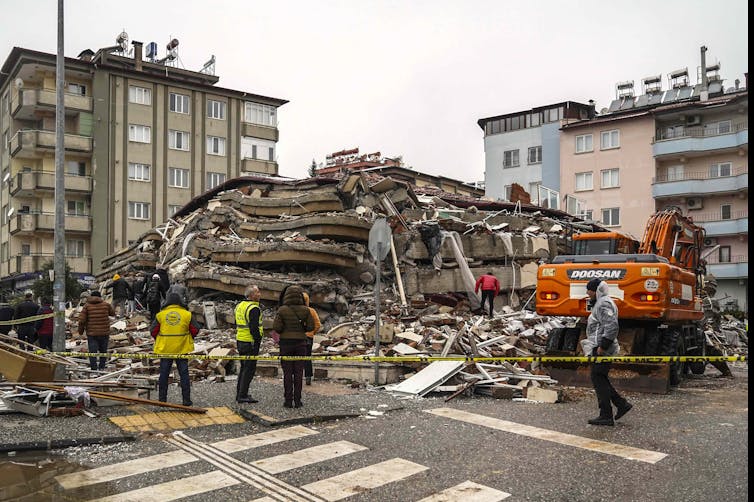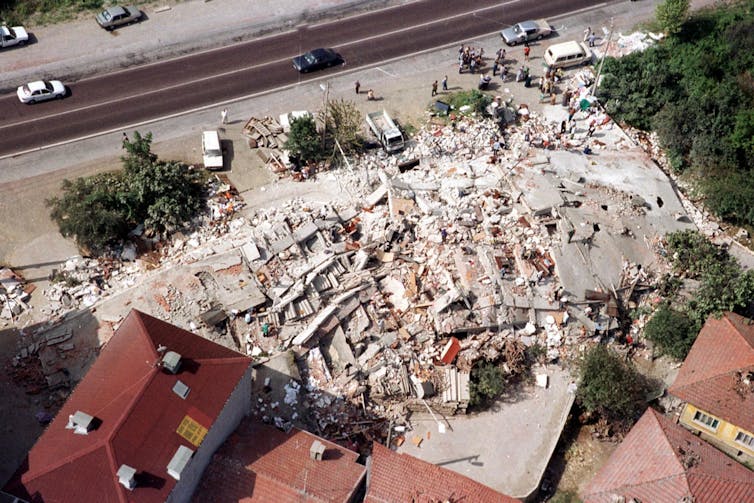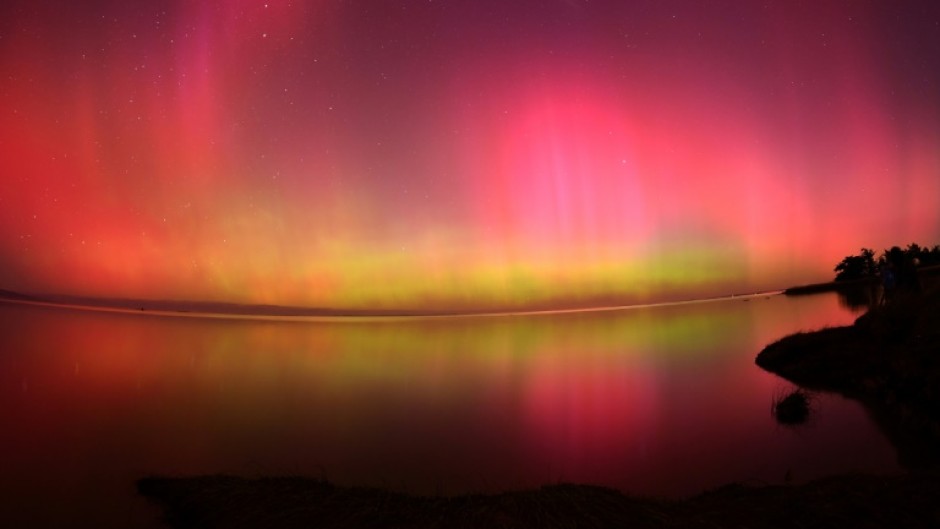
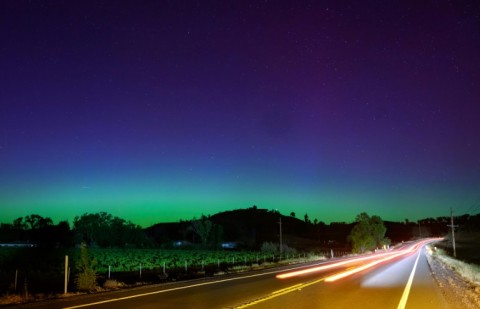
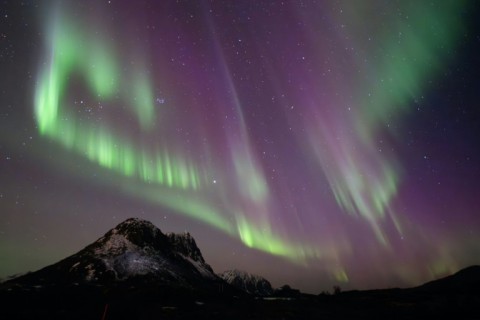

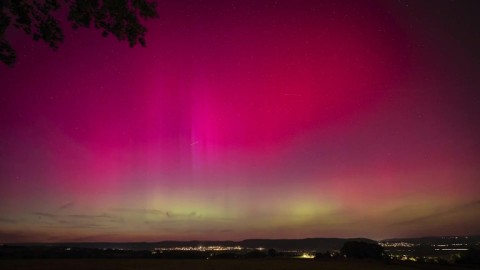





.jpg?ext=.jpg) The meeting of the G7 ministers (Image: G7 Italia)
The meeting of the G7 ministers (Image: G7 Italia)
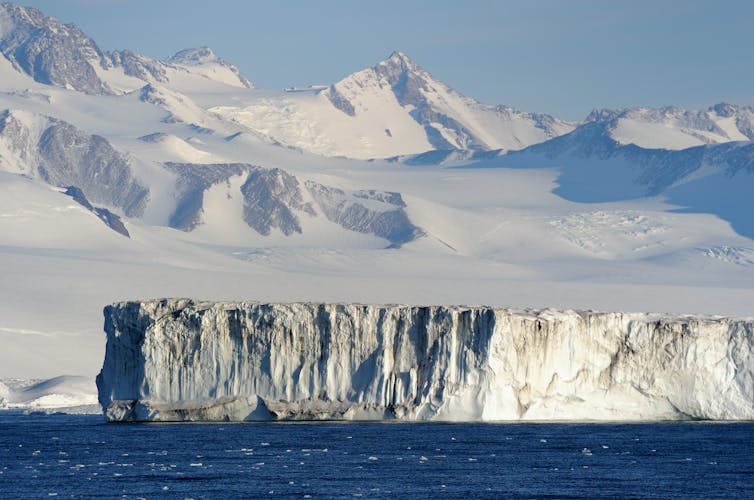 AndreAnita/Shutterstock Maurice Huguenin, UNSW Sydney; Matthew England, UNSW Sydney, and Paul Spence, University of Tasmania
AndreAnita/Shutterstock Maurice Huguenin, UNSW Sydney; Matthew England, UNSW Sydney, and Paul Spence, University of TasmaniaAs the weight of ice builds up, the ice sheet begins to move towards the oceans. When it reaches the sea, the ice floats. These floating extensions are known as ice shelves. The largest is over 800 kilometres wide.
When the ocean water has a temperature close to 0°C, these ice shelves can persist for a long time. But when temperatures rise, even a little, the ice melts from below. Antarctic ice shelves are now losing an alarming 150 billion tons of ice per year, adding more water to the ocean and accelerating global sea level rise by 0.6 mm per year. Ice shelves in West Antarctica are particularly prone to melting from the ocean, as many are close to water masses above 0°C.
While the melting trend is clear and concerning, the amount can vary substantially from year-to-year due to the impact of both natural climate fluctuations and human-made climate change. To figure out what is going on and to prepare for the future, we need to tease apart the different drivers – especially El Niño-Southern Oscillation, the world’s largest year-to-year natural climate driver.
Our new research explores how heat brought by El Niño can warm the ocean around West Antarctica and increase melting of the ice shelves from below.
Australians are very familiar with the two phases of this climate driver, El Niño and La Niña, as they tend to bring us hotter, dryer weather and cooler, wetter weather, respectively. But the influence of this cycle is much larger, affecting weather and climate all around the Pacific.
Can it reach through Antarctica’s cold, fast currents of air and water? Yes.
Giant convective thunderstorms in the Pacific’s equatorial regions move east during El Niño and intensify in the West during La Niña. As these storm systems change, they excite ripples in the atmosphere that are able to travel large distances, just as waves can cross oceans. Within two months, these atmospheric waves reach the Antarctic continent, where their energy can affect the coastal atmosphere and ocean circulation. During El Niño, the energy from these waves weakens the easterly winds off West Antarctica (and vice versa for La Niña).
Using satellite data, researchers recently found that West Antarctic ice shelves actually gain height but lose mass during El Niño. That’s because more low-density snow falls at the top of the ice shelves, while at the same time more warm water flows under the ice shelves where it melts compressed high-density ice from underneath.
What we don’t yet know is how this warmer water (above zero) comes up from below. Similarly, we don’t know what happens during La Niña.
Answering these questions with the few observations we have from Antarctica is challenging because this climate driver doesn’t happen in isolation. Storms, tides, large eddy currents and other climate drivers such as the Southern Annual Mode can change the temperatures of the water under ice shelves too, and they can occur at the same time as El Niño.
So how did we do it? Modelling.
We take a high-resolution global ocean circulation model and added El Niño and La Niña events to the baseline simulation. By doing so, we can examine what these anomalies do to the currents and temperatures around Antarctica.
The energy brought by El Niño’s atmospheric waves to West Antarctica weakens the prevailing easterly winds along the coasts.
Normally, most of the warm water reservoir is located off the continental shelf rather than on the continental shelf. As the winds weaken, more of this warmer water – known as Circumpolar Deep Water – is able to flow onto the continental shelf and near the base of the floating ice shelves.
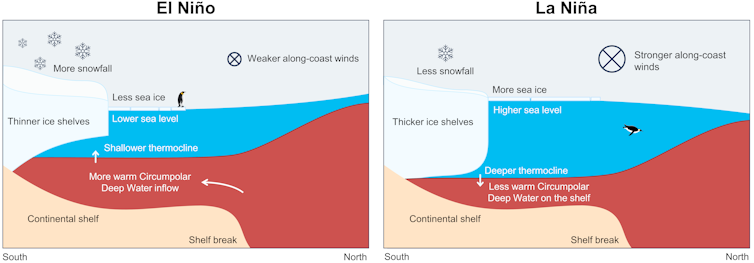 During El Niño, weaker winds along the coasts push less cold Antarctic surface waters towards the continent, allowing warmer Circumpolar Deep Water to flow to the base of the ice shelves. During La Niña, stronger winds drive a wedge of cold water up towards the continent, reducing the inflow of warm water. Maurice Huguenin, CC BY-SA
During El Niño, weaker winds along the coasts push less cold Antarctic surface waters towards the continent, allowing warmer Circumpolar Deep Water to flow to the base of the ice shelves. During La Niña, stronger winds drive a wedge of cold water up towards the continent, reducing the inflow of warm water. Maurice Huguenin, CC BY-SAWe call this water mass “warm”, but that’s relative – it’s only 1–2°C above freezing, and the heat only warms the water on the continental shelf by about 0.5°C. But that’s enough to begin melting ice shelves, which are at or below freezing point.
As you’d expect, the longer the warm water stays on the shelf and the hotter it is, the more melting occurs.
During La Niña, the opposite occurs and the ice rebounds. Winds along the coast strengthen, pushing more cold surface water onto the continental shelf and preventing warm water from flowing under the ice shelves.
Researchers have found El Niño and La Niña have already become more frequent and more extreme.
If this trend continues, as climate projections suggest, we can expect warming around West Antarctica to get even stronger during El Niño events, accelerating ice shelf melting and speeding up sea level rise.
More frequent and stronger El Niño events could also push us closer to a tipping point in the West Antarctic ice sheet, after which accelerated melting and mass loss could become self-perpetuating. That means the ice wouldn’t melt and reform but begin to steadily melt.
More bad news? Unfortunately, yes. The only way to stop the worst from happening is to get to net zero carbon emissions as quickly as humanly possible. ![]()
Maurice Huguenin, Postdoctoral research associate in Physical Oceanography, UNSW Sydney; Matthew England, Scientia Professor and Deputy Director of the ARC Australian Centre for Excellence in Antarctic Science (ACEAS), UNSW Sydney, and Paul Spence, Associate professor of oceanography, University of Tasmania
This article is republished from The Conversation under a Creative Commons license. Read the original article.

The impacts of this mild winter were felt across the country and touched all aspects of winter culture. From melting ice castles at Québec’s winter carnival, to a dismal lack of snow at many Western Canada ski resorts, seemingly no part of Canada was unaffected. But the change that will likely be felt most keenly by many Canadians is the loss of a reliable outdoor skating season.
For the second year running, Ottawa’s Rideau Canal Skateway was closed for what should be the peak of the skating season. In 2022-2023, the Skateway did not open at all for the first time ever. This winter, a portion of the Skateway opened briefly in January, but continuing mild temperatures forced a closure again after only four days of skating. In Montréal, fewer than 40 per cent of the city’s outdoor rinks were open in the middle of February.
There is no obvious upside to this story. Outdoor skating in Canada is fast becoming the latest casualty of our failure to confront the reality of the climate crisis.
More than a decade ago, our research group published our first analysis of how outdoor skating was being affected by warming winter temperatures in Canada. We showed that even as of 2005, there was already evidence of later start dates, and shorter skating seasons across most of the country.
These conclusions were echoed by subsequent publications from the RinkWatch project, which has reported consistent declines in skating season length and quality in many Canadian cities.
Meanwhile in Ottawa, skating days on the Rideau Canal Skateway have been trending downwards over the last 20 years. In this time, the typical skating season has decreased by almost 40 per cent, a trend that is clearly correlated with increasing winter temperatures over the same period.
Climate mitigation progress continues to be far too slow.
Global CO2 emissions reached their highest level ever recorded in 2023, and average global temperatures have now reached 1.3 C above pre-industrial temperatures. If these trends continue, we are on track to reach 1.5 C — the lower threshold of the Paris Agreement temperature target — in less than seven years.
In our 2012 paper, we estimated that suitable rink flooding days could disappear across most of southern Canada by mid-century. In a more recent analysis of Montréal’s outdoor rinks, we estimated that the number of viable skating days in Montréal could decrease to zero by as early as 2070.
In hindsight, these and other similar projections may have been far too optimistic. In a study of Rideau canal skating days published in 2015, the authors projected declining but sustained skating conditions throughout this century, even in a high future emissions scenario. The reality of the past two seasons shows that skating conditions have deteriorated far more quickly than predicted.
Global temperatures in 2023 were the highest ever recorded, as were winter temperatures in December 2023 and January 2024. Since 1950, winter temperatures in Canada have increased by more than 3 C, which is about three times the rate of global warming over this same period.
Outdoor rinks require at least three consecutive very cold days to establish a foundation of ice, followed by enough cold days to maintain a good ice surface. Temperatures above freezing are poorly tolerated by outdoor rinks, and rain is often disastrous.
A few degrees of warming in January and February temperatures can be the difference between a rink that is skatable and one that is not. As winters continue to warm, the case for building and maintaining outdoor municipal rinks will become harder to justify.
As years go by without any real progress on climate mitigation, it is becoming increasingly difficult to imagine a future in which outdoor rinks will be widely available without artificial refrigeration. Other winter activities will also be affected by changing snow conditions, but outdoor skating will likely be hit first in direct response to warming winter temperatures.
Wayne Gretzky famously learned to skate and play hockey in Branford, Ont. in the 1960s on an outdoor rink built by his father. Reliable winter skating conditions in southern Ontario are already mostly a thing of the past, and are becoming more and more scarce as global warming progresses. It is increasingly unlikely that current and future generations will be able to follow Gretzky’s path.
This reality is both a tragic injustice for many young Canadians and an existential threat to a core aspect of the Canadian winter identity.
Preserving what remains of Canada’s winter skating culture will require that we rapidly step up our efforts to drive down CO2 emissions and stabilize global temperatures. Otherwise, Joni Mitchell’s “river I could skate away on” will become an increasingly wishful dream that soon will exist only in the lyrics of old songs.![]()
H. Damon Matthews, Professor and Climate Scientist, Department of Geography, Planning and Environment, Concordia University and Mitchell Dickau, PhD Candidate, Geography, Planning, and Environment Department, Concordia University
This article is republished from The Conversation under a Creative Commons license. Read the original article.
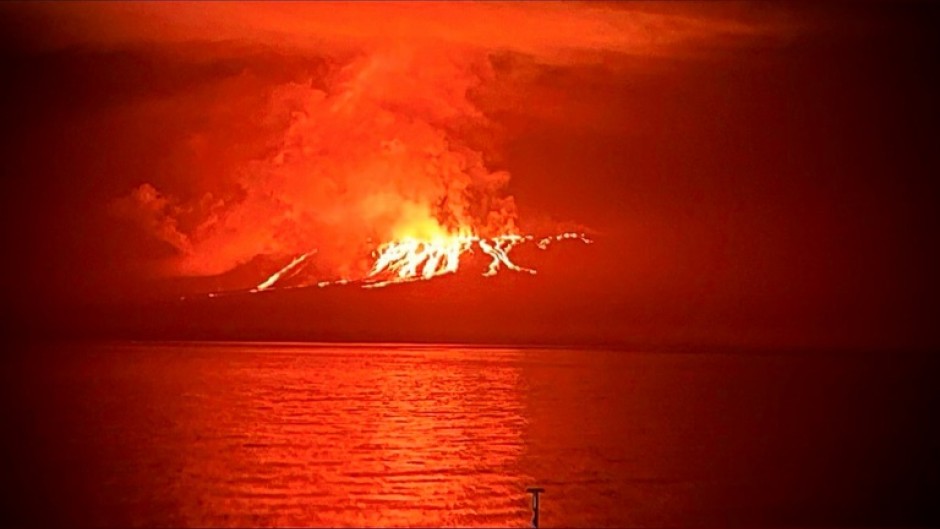

Our planet has warmed by about 1.2°C since 1850. But this warming is not uniform. Warming at the poles, especially the Arctic, has been three to four times faster than the rest of the globe. It’s a phenomenon known as “polar amplification”.
Climate models simulate this effect, but when tested against the past 40 years of warming, these models fall short. The situation is even worse when it comes to modelling past climates with very high levels of greenhouse gases.
This is a problem because these are the same models used to project into the future and forecast how the climate will change. They are likely to underestimate what will happen later this century, including risks such as ice sheet melting or permafrost thawing.
In our new research published today in Nature Geoscience we used a high-resolution model of the atmosphere that includes the stratosphere. We found a special type of cloud appears over polar regions when greenhouse gas concentrations are very high. The role of this type of cloud has been overlooked so far. This is one of the reasons why our models are too cold at the poles.
Looking into past climates can give us glimpses of possible futures for a range of extreme conditions. For us, this means we can use Earth’s history to find out how well our climate models perform. We can test our models by simulating episodes in the past when Earth was much warmer. The advantage of this is that we have temperature reconstructions for these episodes to evaluate the models, as opposed to the future, for which measurements are not available.
If we go back 50 million years or so, our planet was very hot. Carbon dioxide (CO₂) concentrations ranged between 900 and 1,900 parts per million (ppm), compared with 415 ppm today. Methane (CH₄) concentrations were likely also much higher.
Canada’s arctic archipelago was covered in lush rainforests inhabited by alligators, turtles, lizards and mammals.
For these plants and animals to survive, conditions must have been warm and ice-free year-round. Indeed, surface ocean temperatures exceeded 20°C near the north pole (at about 87°N) and 25°C in the Southern Ocean (at about 67°S).
This period called the early Eocene is a perfect test bed for our models, because it was globally very warm, and the poles were even warmer, meaning it was a climate with extreme polar amplification. In addition, the Eocene is recent enough for temperature reconstructions to be available.
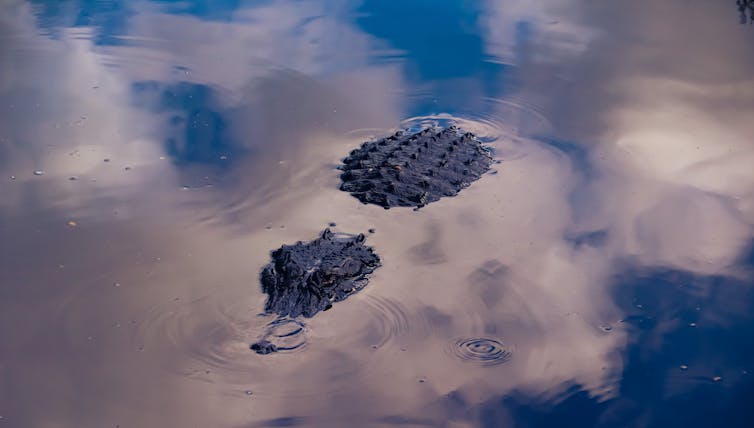 Alligators, turtles, lizards and mammals lived in the Arctic about 50 million years ago, when it was much warmer than today. Bradley GT, Shutterstock
Alligators, turtles, lizards and mammals lived in the Arctic about 50 million years ago, when it was much warmer than today. Bradley GT, ShutterstockIn 1992 American paleoclimatologist Lisa Sloan suggested polar stratospheric clouds might have caused extreme warming at high latitudes in the past.
These clouds are a rare and beautiful sight today. They are also called nacreous or mother-of-pearl clouds for their vivid and sometimes luminous colours.
They form at very high altitudes (in the stratosphere) and at very low temperatures (over the poles). In the present day climate, they appear mainly over Antarctica, but have also been observed during winter months over Scotland, Scandinavia and Alaska, at times when the stratosphere was particularly cold.
Just like greenhouse gases, they absorb infrared radiation emitted by the Earth’s surface and re-emit a portion of this energy back to the surface. This suggests polar stratospheric clouds could be one of the missing puzzle pieces.
They warm the surface. And their effect could be significant, especially in winter, when the sun does not rise. But they are difficult to simulate in a climate model, so most models ignore them. This omission could explain why climate models miss some of the polar warming, because they miss a process that warms the poles.
Three decades after Sloan’s paper, a few atmosphere models are finally complex enough to allow us to test her hypothesis. In our research we use one of them and find that under certain conditions, the additional warming due to these polar stratospheric clouds exceeds 7°C during the winter months. This significantly reduces the gap between climate models and temperature evidence from the early Eocene. Sloan was right.
Our research explains why climate models don’t work so well for past climates when greenhouse gas levels were much higher than they are today. But what about the future? Should we be concerned?
There is some good news. While polar stratospheric clouds do warm the poles, they won’t be as common in the future as they were in the distant past, even if both CO₂ and CH₄ reach very high levels.
This is due to another difference between the Eocene and today: the position of continents and mountains, which were different back then and which also influence the formation of polar stratospheric clouds. So even if we hit early Eocene levels of CH₄ and CO₂ in the future, we would expect less polar stratospheric cloud to be formed. This suggests the standard climate models are better at predicting the future than the past.
It’s therefore unlikely the Arctic and Antarctica will be covered by these beautiful clouds anytime soon. But our research shows evidence from past climates can reveal processes that only become important when greenhouse gas concentrations are high. Some of these processes are not included in our models because models are tested against present day observations and other processes simply seemed more important to include. Looking into the past is a way of broadening our horizon and learning for the future.![]()
Katrin Meissner, Professor and Director of the Climate Change Research Centre, UNSW, UNSW Sydney; Deepashree Dutta, Postdoctoral Research Associate, University of Cambridge, and Martin Jucker, Lecturer in Atmospheric Dynamics, UNSW Sydney
This article is republished from The Conversation under a Creative Commons license. Read the original article.
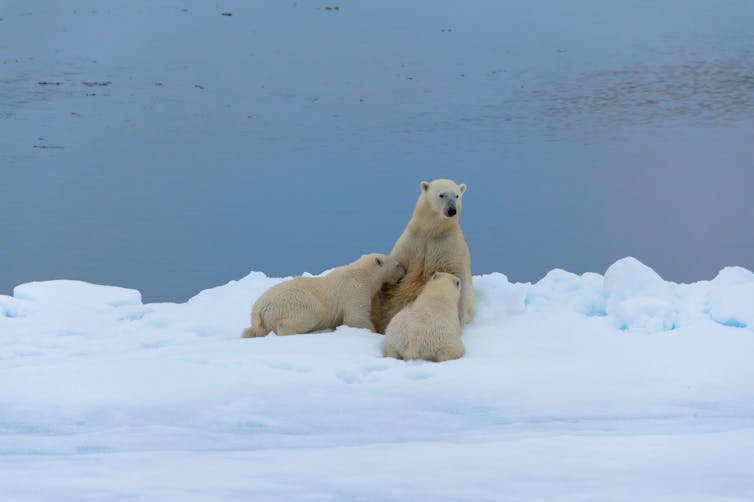 During their time onshore, polar bear mothers may risk their survival by continuing to nurse when food is not available. (Shutterstock)
Louise Archer, University of Toronto
During their time onshore, polar bear mothers may risk their survival by continuing to nurse when food is not available. (Shutterstock)
Louise Archer, University of TorontoWhen sea ice melts, polar bears must move onto land for several months without access to food. This fasting period is challenging for all bears, but particularly for polar bear mothers who are nursing cubs.
Our research, published in Marine Ecology Progress Series, found that polar bear lactation is negatively affected by increased time spent on land when sea ice melts.
Impaired lactation has likely played a role in the recent decline of several polar bear populations. This research also indicates how polar bear families might be impacted in the future by continued sea-ice loss caused by climate warming.
While sea ice might appear as a vast and perhaps vacant ecosystem, the frozen Arctic waters provide an essential platform for polar bears to hunt energy-rich seals — the bread and butter of their diet.
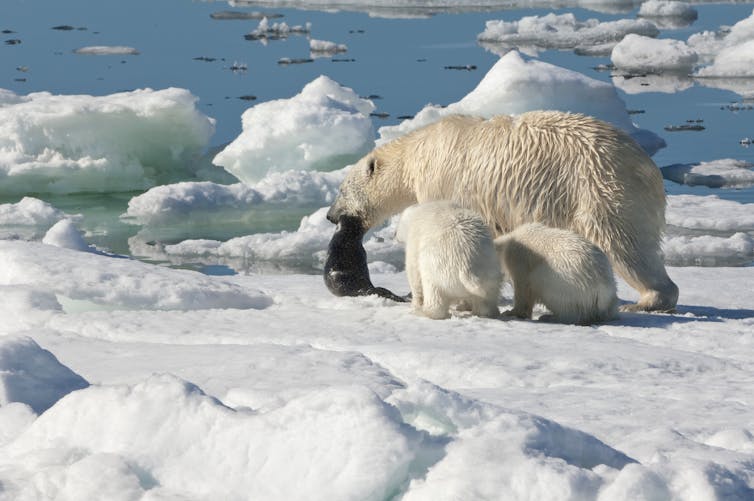 On shore, polar bears often remain in a fasting state, using their body stores of fat for fuel. (Shutterstock)
On shore, polar bears often remain in a fasting state, using their body stores of fat for fuel. (Shutterstock)While on shore, hunting opportunities are rare and polar bears generally spend their time in a fasting state. Polar bears rely on their immense body fat stores to fuel them during these leaner months, with some individuals measuring almost 50 per cent body fat when they come onshore in early summer.
While on land, polar bears can lose around a kilogram of body mass per day, so making it to the end of the ice-free season requires them to carefully manage their energy. For most polar bears, this means reducing activity levels and conserving energy until the sea ice returns and seal hunting can resume.
Females with cubs must also factor in the additional burden of lactation. Polar bears produce high-energy milk, which — at up to 35 per cent fat — is like whipping cream. This high-fat milk allows cubs to grow quickly, increasing from just 600 grams at birth to well over 100 kilograms by the time they are around two-and-a-half years old and leave their mothers to become independent.
Although lactation is important to both mothers and cubs, studies on polar bear lactation are relatively rare.
To better understand how females manage their lactation investment, our research team revisited a data set of polar bear milk samples collected in the late 1980s and early 1990s from polar bears on land during the ice-free period.
We estimated how long each polar bear mom had been fasting based on annual sea-ice breakup dates and found that the energy content of their milk declined the more days spent onshore. Some bears had stopped producing milk entirely. Both milk energy content and lactation probability were negatively related to the mother’s body condition, meaning females in poor body condition had to prioritize their own energetic needs over their cubs.
The bears who reduced their investment in lactation benefited by using up less of their body reserves, meaning they could fast for longer. Yet the cubs who received lower energy milk grew more slowly than offspring of females that maintained their lactation effort. In the long term, this may reduce cub survival and, ultimately, negatively affect population dynamics.
After around three months on land, the probability of a female with cubs lactating was 53 per cent. This dropped to 35 per cent for a female with yearlings (older cubs from the previous year).
The data in our study were collected around three decades ago. Since then, climate warming has meant that the ice-free season in western Hudson Bay has been extending by around seven days per decade. Polar bears are now regularly forced to spend more than four months on land.
As the ice-free season has increased and polar bears must go for longer without food, their average body condition has declined. The ability of female polar bears to nurse their cubs has probably also become increasingly impaired.
This may have contributed to the 50 per cent decline in the population size of the western Hudson Bay population over the last four decades, and is likely to contribute to further declines if climate warming and sea-ice declines continue as projected without mitigation.
This research adds another piece to our understanding of polar bear resilience to climate change. Without action to halt climate warming and sea-ice loss, survival of cubs will be at risk across the Arctic.![]()
Louise Archer, Postdoctoral Fellow, Biological Sciences, University of Toronto
This article is republished from The Conversation under a Creative Commons license. Read the original article.

 Jonathan Symons, Senior Lecturer, Macquarie School of Social Sciences, Macquarie University This article is republished from The Conversation under a Creative Commons license. Read the original article.
Jonathan Symons, Senior Lecturer, Macquarie School of Social Sciences, Macquarie University This article is republished from The Conversation under a Creative Commons license. Read the original article.